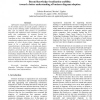Free Online Productivity Tools
i2Speak
i2Symbol
i2OCR
iTex2Img
iWeb2Print
iWeb2Shot
i2Type
iPdf2Split
iPdf2Merge
i2Bopomofo
i2Arabic
i2Style
i2Image
i2PDF
iLatex2Rtf
Sci2ools
98
Voted
IV
2009
IEEE
2009
IEEE
Beyond Knowledge Visualization Usability: Toward a Better Understanding of Business Diagram Adoption
Information visualization research typically focuses on the formal aspects of specific graphic solutions in terms of their thinking and/or communication support. This type of analysis often focuses on quantitative diagrams and emphasizes their attributes for specific tasks. Our contribution, by contrast, focuses on qualitative visual solutions and the factors that contribute to their wider diffusion. As many knowledge visualization solutions have not achieved wider use, the question of which factors foster diagram adoption seems to be a particularly relevant but underresearched topic. In this paper we develop and discuss three dimensions that foster knowledge visualization adoption: perceived ease of use, perceived usefulness and perceived authority. We base our analysis on the Technology Adoption Model by Davis and the Perceived Characteristics of Innovations by Rogers. We illustrate these dimensions and their items through examples of business diagrams that have received wide recogn...
Information Technology | Information Visualization Research | IV 2009 | Knowledge Visualization | Specific Graphic Solutions |
| Added | 24 May 2010 |
| Updated | 24 May 2010 |
| Type | Conference |
| Year | 2009 |
| Where | IV |
| Authors | Sabrina Bresciani, Martin J. Eppler |
Comments (0)

